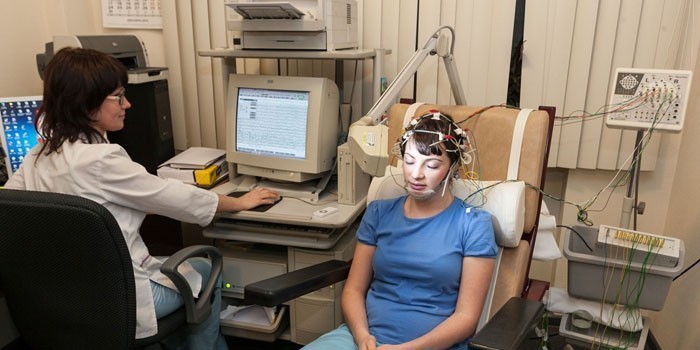If a person complains about his condition to a neurologist, the doctor applies the necessary diagnostic methods to identify changes that have occurred inside the cranium and caused the disease. One of the very informative studies that specialists often do in such cases is an electroencephalogram of the brain.
What is EEG
What kind of examination does this abbreviation mean? At first glance, it is difficult to figure out whether an electroencephalogram or an EEG of the brain is what it is. You need to know: although the name of the examination looks complicated, it implies a painless diagnosis. On the surface of the patient's head, special sensors-electrodes are superimposed, capable of capturing the activity of different parts of the brain. Thanks to special equipment, such impulses are amplified in the form of characteristic curved lines, displayed on special paper or in a computer version.
EEG of the brain - what it shows
The results of encephalography indicate the functional activity of the examined brain. Such a diagnosis can be assigned to both an adult and a child. What does an encephalogram show? After decoding the results of this examination, the doctor has a complete understanding of the state of the brain. EEG displays the activity of this organ in case of lesions of the central nervous system - meningitis, encephalitis, etc. If the vessels are damaged in the brain or tumors develop, then the specialist will be able to determine where the damaged area is located.
Patients who have been diagnosed with or were suspected of having epilepsy know exactly what the EEG is - what it is and how it is diagnosed. An encephalogram of the brain is the main method by which this disease is detected. During the study, they even deliberately provoke seizures in order to clarify their origin, and then choose an adequate treatment. They are recorded on a camera, this technique is called EEG video monitoring. The doctor determines whether only a daytime, shorter procedure is sufficient for making a diagnosis, or whether it is necessary to do a night survey while the patient is sleeping.
EEG decoding
According to the results of the electroencephalogram, the specialist receives data on the regular rhythms of the brain - alpha, beta, theta, delta rhythms. EEG decoding consists in analyzing the rhythm of such waves, their amplitude and frequency, and comparing the obtained monitoring results with the symptoms observed in the patient. By the nature of the changes in these rhythms relative to the normal indicators characteristic of a healthy person, it is determined what pathological changes occur in the brain. The data obtained during the diagnosis is displayed in the conclusion.
EEG decoding in children - the norm and violations
Head encephalogram is an examination that should be carried out for a child if he has abnormalities in speech, motor or mental development. EEG of the brain in children detects disorders in the work of this most important organ, so that they can be corrected by doctors as soon as possible. You need to know that the norms of the electroencephalogram indicators differ depending on the age of the baby, therefore, only an experienced specialist can correctly decipher the diagnostic data.
EEG monitoring accurately shows differences in brain rhythms from statistically verified diagnostic norms. Its decoding reliably reveals various disorders in the child:
- perinatal pathologies;
- autism;
- epileptic activity;
- causes of disturbances in the sleep and wakefulness cycle;
- meningitis;
- tumor processes.

Where can an EEG be done
The main indicators of where to go to conduct such a study should be the qualifications of the specialists doing the encephalogram and the technical equipment of the laboratory. By comparing these factors, as well as the cost of taking readings, the patient can reasonably decide where an EEG can be done. Today, such diagnostics are carried out both in state medical institutions - neurological departments or psychiatric dispensaries, and in private medical centers. Children under 14 years of age are examined by pediatric neurologists in children's hospitals.
How an EEG is done
Even a person who fearfully perceives any medical manipulations should not worry about such an examination, because it is absolutely painless. Preparation for the EEG consists in a full night's sleep before the day of the study, the absence of influence on the subject of stress, psychomotor agitation. Alcohol, tranquilizers, sedatives, coffee should not be consumed two days before the diagnosis. First you need to wash your hair without using styling products. You should eat 2 hours before the procedure.
How is EEG done? The patient is invited to a light and sound proof room. Using a special gel, a cap assembled from electrodes and connected to an electric encephalograph is fixed on his head. The examinee sits comfortably or lies on the couch and performs the necessary tests as directed by the doctor: closes and opens his eyes, breathes deeply, etc. The duration of the procedure can be from 45 minutes to several hours.

EEG price
The cost of such a diagnosis depends on where the electroencephalography of the brain is performed. In public hospitals, the price of an EEG is 400-1500 rubles. How much you have to pay for this examination in a private medical center depends on the status of the institution, the qualifications of specialists, etc. The cost of diagnostics here ranges from 1,500 to 3,000 rubles.

